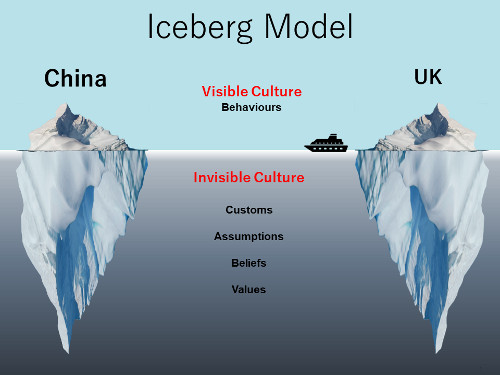2 Culture and the perspective of others
One of the main objectives of this taster course is to raise your awareness of how we often take our own cultural values to be the norm and how stereotypes of a particular culture can be formed that may hamper communication.
When communicating with individuals that belong to a different cultural milieu, you should be aware of cultural differences, but it is also important to acknowledge the fact that there is usually a great number of overlapping similarities.
It is natural to register what you find surprising, rather than what you find normal, and this creates unconscious generalisations. However, these cultural generalisations and stereotypes are prone to being based on biased impressions and experiences, involuntarily exaggerated or limited to specific environments. Moreover, they usually apply to the most visible parts of culture (the surface of the iceberg), which are the more conspicuous behaviours of cultural aspects such as food, traditions, rites, etc.
Prejudice arises when negative judgements are applied to these stereotypes.
Activity 2
In the TED talk ‘The Danger of a Single Story’, the novelist Chimamanda Adichie tells the story of how she found her authentic cultural voice, and warns that if only a single story about another person or country is heard, there is a risk of critical misunderstanding.
Watch the video and answer the following questions.
1. What are the consequences of a single story according to Chimamanda Adichie?
Feedback
In the video, Adichie says:
The consequence of a single story is this: it robs people of dignity. It makes our recognition of equal human dignity difficult. It emphasises how we are different rather than how we are similar.
If you are not aware of the different practices and beliefs of people you work with who are from different cultures, you run the risk of having a biased view towards a particular culture. As a result, you will not be able to develop the skills and attitudes needed to get along with colleagues who come from different cultures.
2. If you have been hearing a single story about Chinese culture, what is it? Describe it in the following box.
Feedback
Just a few prompts to get you thinking: Is the story about how polluted Chinese cities are, which causes all Chinese people to wear masks? Is it about people jumping queues and being rude? Or is it about beautiful calligraphy and papercutting?
3. If you have heard a single story, after watching the TED talk above, what are your views now towards Chinese culture?
Feedback
As Adichie says:
The single story creates stereotypes, and the problem with stereotypes is not that they are untrue, but that they are incomplete. They make one story become the only story.
The story you have heard or experienced relating to Chinese culture is just one experience of many. China is a huge country with a big population, regional differences and 56 minority groups. Whenever you hear a story, positive or negative, you must not jump to conclusions but instead connect it with other stories and figure out the reasons behind it.

